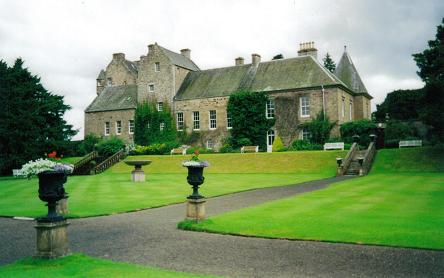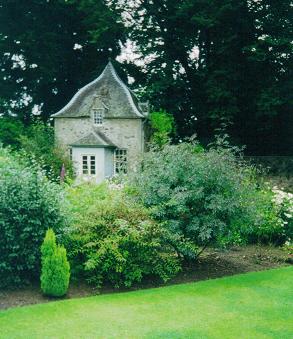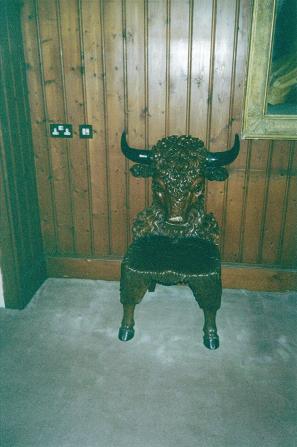

| Home Contents Contact |
|
|

Murthly Castle, Perthshire
One of the most nebulous and poorly documented Native American presences in Scotland is that of two full-blood Indians, reputed to have accompanied Sir William Drummond Stewart (1795 - 1871) to his family seat at Murthly Castle, near Dunkeld, Perthshire, in 1839.Sir William Drummond Stewart, a decorated veteran of the Napoleonic Wars who first set sail for North America in 1832, was one of a breed of aristocratic adventurers who during the first half of the 19th century came to conceive of the American West as one vast playground and who reversed the ancient theme of the ‘noble savage’, re-inventing themselves as ‘savage nobles’.
Sir William rubbed shoulders with many of the frontier notables of the day. His adventures and tense encounters with the Indians were legion but the most engaging part of his story for present purposes only begins with his return to Scotland during the summer of 1839, prompted by news of the death of his elder brother and consequent succession to the family titles and estates as the 19th Lord of Grandtully and 7th Baronet of Murthly.
Even more remarkable than Sir William himself was his entourage of his human and animal exotica. He established a breeding herd of buffalo on the slope of Birnam Hill on the south bank of the Tay, together with numerous other examples of American flora and fauna. To this day, there is a splendid terrace of Douglas Firs in the gardens and an avenue of magnificent Sequoia trees lines the long driveway.
One member of Sir William’s retinue was Antoine Clement, the son of a French-Canadian voyageur in the service of the Hudson Bay Company and a Cree mother. Antoine was prevailed upon to cut his hair and otherwise modify his appearance during his time at Murthly, where he donned a black suit and assumed the role of Sir William’s valet. On one occasion, however, he was persuaded to model the full regalia of an Indian chief, to the astonishment of guests in the drawing room and the terror of the servants.
The principal source for the story of Sir William and his Indian companions is Scotsman in Buckskin (New York: Hastings House, 1963) by Mae Reed Porter and Odessa Davenport but in this book the two full-bloods alleged to have belonged to the party constitute a shadowy presence, of which very little in the way of concrete information is actually known.

According to the Porter and Davenport account, Sir William and his party disembarked at Glasgow, presumably on the Broomielaw, the full-bloods making their conspicuous first appearance on Scottish soil in buckskins, blankets, moccasins and long black hair. A further anecdote related in Scotsman in Buckskin is that one night, fuelled by a lethal mix of drunkenness and boredom, Antoine and the two full-bloods engaged in a wild escapade, binding a large row-boat onto four wagon wheels and hitching it to a pair of buffalo. They next proceeded to drive at full tilt through the streets of Dunkeld, to the accompaniment of wild warwhoops, shattering the nerves of the inhabitants of this usually placid locality.
The story, whose veracity apparently rests on hearsay evidence, is elaborated on by George Forbes in his article The Laird of the Wild West1. According to Forbes’s version, the Indians were halted in their mad career when, on the bridge across the River Tay, their hastily improvised vehicle collided with the overnight mail coach which had selected this inopportune moment to arrive from Inverness. Whether this extraordinary yarn holds any firm basis in reality now seems impossible to determine but must be considered unlikely.
When I visited Murthly Castle in August 2000, I was assured that the Indians at Murthly were lodged in the building left.

The bridge, constructed in 1809 by Telford, is said to have been the site on which a mail coach was involved in a head-on collision with a vehicle pulled by buffalo and driven by Indians.In endeavouring to chart the careers of Sir William Drummond Stewart’s Indians at Murthly Castle, one is strongly tempted simply to conclude - ‘Let’s forget about being professional historians for a while and have some fun instead.’ Not even the names or the tribal affiliation of the full-bloods appear to be documented and one is led to question whether they existed at all.
In Scotsman in Buckskin, the Indians abruptly disappear from the account. After their return to the United States in 1842, when Sir William was about to embark upon his final American adventure, they and Antoine were sent on to St Louis, where they were to await further instructions. There are several later references to Antoine and the question of how, when and why he came to take his leave of Sir William is fully settled but, of the Indians, there is not a single further word more.
Had these Indians tired of the Scottish rain, or, like so many Native American sojourners before and since, did they succumb to some passing epidemic and perish? In the form in which the story was first orally recounted to me, the Indians did not return to their homeland but died of an illness and were buried somewhere along the banks of the Tay. As heathens, they could not be buried in consecrated ground. There was even mention made of a man who helpfully pointed out the exact spot at which this interment is supposed to have taken place. However, as with so much of the story, a great deal depends upon unsubstantiated folklore and the written record is desperately lacking. I have identified a number of contemporary newspaper articles, which make abundant mention of Sir William’s various comings and goings and exotic animals but there is not a single reference yet discovered to the Indians.
It is not even clear what became of the buffalo. According to one permutation, they were removed, after goring one estate worker too many, to a stately home in England. All that is known for sure is that they are not there now. Once again, there is anecdotal evidence to rely upon and little else.
Another distinguished American guest at Murthly around the same time was Alfred Jacob Miller. One of a remarkable generation of artists who did so much to preserve a record of the American West during this period, Miller lodged at Murthly from the summer of 1840 until his departure for London in November 1841.
Miller set to work on translating his sketches into oil paintings and his masterpiece The Trapper’ Bride was one of the works completed at Murthly. When I visited Murthly Castle in August 2000, the Miller originals Indian Girl Swinging and The Death of the Cougar graced walls of the entrance hall, while An Attack of the Crows on the Whites at the Big Horn hung majestically over a stairway.

In addition to his various living specimens, Sir William also brought with him various inanimate souvenirs of his American adventures. During my visit to Murthly, I was delighted to discover a pair of carved buffalo chairs, whose existence I had read of in Scotsman in Buckskin, still proudly on display in the entrance hall. Footnotes:
1 Scottish Memories, April 1993, p. 19


